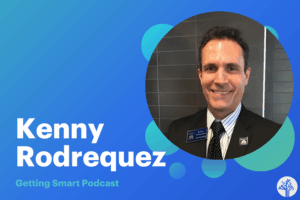7 Ways State Policy Can Promote Competence

Since Horace borrowed the idea from the Prussians, we’ve been batch-processing kids based on birthdays through a print curriculum. This batch-print system was moderately efficient until we tried to retrofit it to work for all kids. It just created a mess of tacked on services and a crazy patchwork quilt of courses. As educational demands of society increase, it becomes increasingly obvious that the batch-print system doesn’t work well for at least two thirds of our kids.
Many of us believe that personalized learning environments where students progress as they demonstrate mastery hold the promise to boost achievement and completion rates for struggling students while speeding accelerated students through the K-16 system several years faster than is common today. However, the transition to a competency-based system is pedagogically, politically, and technically challenging. Despite policy barriers there are thousands of schools creating these next generation blended and competency-based environments. To accelerate the shift and improve outcomes, states should address these 7 things now.
1. Standards. Embrace a broad view of college and career readiness expressed in standards and graduation requirements. Maine went a step further and adopted a requirement for a proficiency-based graduation (discussed on CompetencyWorks).
2. Assessments & Accountability. Week-long year end summative tests and a singular focus on rates of grade level proficiency lock in the old age cohort model–and it doesn’t serve struggling or accelerated students well. States (and state consortia) should migrate away from heavyweight summative assessments to on-demand (or frequently scheduled) elementary grade level and secondary end of course exams. Students should be able to demonstrate mastery when they’re ready–and if they’re not ready they should get more time and targeted assistance. (See DLN section on Advancement.)
Most districts and networks will want to use more frequent gateways than end of course and they’ll combine multiple assessments at a unit level to determine competence. All of these standards-aligned assessments can be used to create comparable individual student growth measures.
With standardized ways of combining classroom formative assessment, states can ditch the big end of year standardized tests. States could use growth rates and a sampling strategy (like NAEP) to confirm school quality.
3. Time. States should ditch seat time requirements. Blended learning environments also benefit from flexibility in staffing ratios. (See OpportunityCulture for 20 examples.)
4. Funding. Changing how students are organized and how they move through the system requires a new approach to funding schools. With weighted, flexible, portable, and performance-based funding, schools budgets reflect actual challenges with the flexibility to create a blended and competency-based environment.
5. Course Access. A competency-based secondary system is added by access to a couple different learning options (e.g., blended or online), career oriented pathways, expanded electives, and a variety of college credit options. (See DLN paper on Making the Most of State Course Access Programs.)
6. Guidance. With every student on a unique learning trajectory and more secondary options, every student needs a strong sustained guidance program–probably delivered through an advisory structure–with links to academic and family support services. (See DLN paper on Guiding and Personalizing College & Career Readiness.)
Like Texas (HB 5), states could require a college and career ready plan and provide a web of support like Communities in Schools. LIke Louisiana Supplemental Course Academy, states could provide online counselors. Like Washington, states could provide a statewide licence to an online guidance system.
7. Entry points. Like the Ohio Straight A Fund, states could support sustainable innovation. States could provide matching funds to regional programs like NGLC Breakthrough Schools. Like Michigan’s Education Achievement Authority (recent feature), school improvement networks can be a viable place to pilot competency-based models.
For more, see:
- DLN: The Shift From Cohorts to Competency
- Getting Smart: 10 Elements of Competency-Based Learning
- iNACOL: A K-12 Federal Policy Framework for Competency Education: Building Capacity for Systems Change
- CompetencyWorks: Necessary for Success: A State Policymakers Guide to Competency Education
- KnowledgeWorks: Competency Education Series: Policy Brief One
- Christensen Institute: From Policy to Practice: How Competency-Based Education Is Evolving in New Hampshire
Digital Learning Now is a Getting Smart Advocacy Partner.







0 Comments
Leave a Comment
Your email address will not be published. All fields are required.